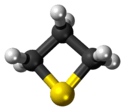Thietane
| |||
| Names | |||
|---|---|---|---|
| IUPAC name
Thietane | |||
| Other names
Thiacyclobutane Trimethylene sulfide | |||
| Identifiers | |||
| 102383 | |||
| 287-27-4 | |||
| ChemSpider | 8895 | ||
| EC number | 206-015-0 | ||
| |||
| Jmol-3D images | Image | ||
| PubChem | 9251 | ||
| |||
| UN number | 1993 | ||
| Properties | |||
| Molecular formula |
C3H6S | ||
| Molar mass | 74.14 g·mol−1 | ||
| Appearance | Colourless liquid | ||
| Odor | Sulfurous | ||
| Density | 1.028 g cm−3 | ||
| Boiling point | 94 °C (201 °F; 367 K) | ||
| Hazards | |||
| GHS pictograms |   | ||
| GHS signal word | DANGER | ||
| H225, H302 | |||
| P210 | |||
| EU classification | | ||
| R-phrases | R11, R22 | ||
| S-phrases | S16 | ||
| NFPA 704 | |||
| Flash point | -11(9) °C | ||
| Except where noted otherwise, data is given for materials in their standard state (at 25 °C (77 °F), 100 kPa) | |||
| | |||
| Infobox references | |||
Thietane is a heterocyclic compound containing a saturated four-membered ring with three carbon atoms and one sulfur atom.[1][2]
References
- ↑ Leśniak, S; Lewkowski, J; Kudelska, W; Zając, A (2008). "Thietanes and Thietes: Monocyclic". Comprehensive Heterocyclic Chemistry III 2.07: 389–428. doi:10.1016/B978-008044992-0.00207-8.
- ↑ Block, E; DeWang, M (1996). "Thietanes and Thietes: Monocyclic". Comprehensive Heterocyclic Chemistry II 1.24: 773–802. doi:10.1016/B978-008096518-5.00024-1.


